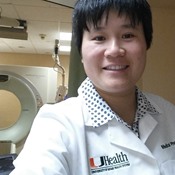Source Position Uncertainty in the Venezia Advanced Gynecological Applicator for High-Dose-Rate Brachytherapy
X Li*, Y Huang, K Hopfensperger, S Bhagroo, H Zhao, J Kunz, G Nelson, F Su, University of Utah, Salt Lake City, UT
Presentations
PO-GePV-T-32 (Sunday, 7/10/2022) [Eastern Time (GMT-4)]
ePoster Forums
Purpose: The Venezia applicator consists of a tandem and two lunar-shaped ovoids, which form a split ring when placed together. This unique design is challenging for identifying source positions during the applicator commissioning. In this study, we propose an effective method to evaluate source position uncertainty in the Venezia ovoids.
Methods: We assessed the source positions with a source positional simulator (SPS) and x-rays imaging. First, we placed the ovoid on a linac kV imager in anteroposterior (AP) and lateral (LAT) orientations, respectively, and inserted the SPS source at different indexers, from 230 to 300 mm with 10 mm increments. We then acquired a series of x-rays images (55kVp, 200mAs) to capture the SPS source positions. On the obtained images, we quantified the source path length (SPL), which is the separation between source positions along the direction of source movement. Finally, we compared the measured SPL with the expected value (10 mm).
Results: The source positions and the lumen were clearly visible on the kV images. Overall, the measured SPLs were close to 10 mm, except for the ones at transition region, where cervix meets vagina. For the 22/26/30 mm ovoid, the averaged SPL at transition region was 6.0/7.4/8.8 mm, which increased to 8.6/9.0/9.1 mm at other indexers. This evidence suggests the source position uncertainty was lower for larger ovoids, and higher at connector ends.
Conclusion: We developed a simple method to characterize source positions with x-ray imaging. Because higher uncertainties existed near the transition region for smaller ovoids, we recommend using larger ovoids for treatment planning when anatomy allows, and lowering the source dwell time at connector end.
Keywords
HDR, Brachytherapy, Commissioning
Taxonomy
TH- Brachytherapy: HDR Brachytherapy
Contact Email



